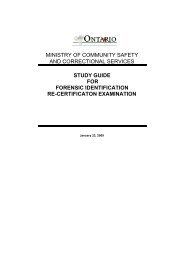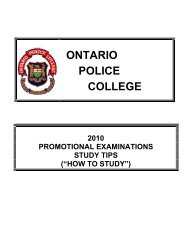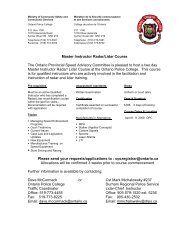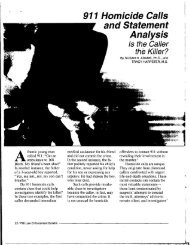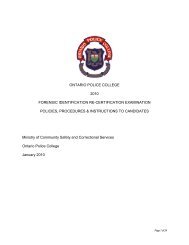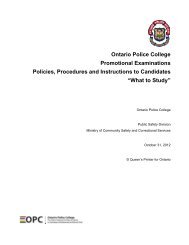General Study Guide - Ontario Police College
General Study Guide - Ontario Police College
General Study Guide - Ontario Police College
You also want an ePaper? Increase the reach of your titles
YUMPU automatically turns print PDFs into web optimized ePapers that Google loves.
For use on CA-treated prints, the liquid is diluted by a factor of 100 or more with methanol<br />
or water. As with the R6G or BY dye, exhibits can be dipped or sprayed, with dipping being<br />
the recommended method.<br />
In the case of all three dyes mentioned above, excess stain can be rinsed off the exhibit with<br />
the pure solvent or a gentle stream of water. Since the dye is not chemically-bound,<br />
vigourous washing can actually remove all of the dye from the latent print as well. This can<br />
be used to advantage if, for example, the background has absorbed a significant amount of<br />
dye, since more aggressive washing can then be used to attempt to clear off more of the<br />
dye. Exhibits can always be re-treated, if washing has removed too much dye. Most<br />
workers seem to agree that a more dilute solution results in less background interference.<br />
Exhibits rinsed with alcohol will usually dry more quickly with fewer spots.<br />
1,8 Diazafluoren-9-One (DFO)<br />
An amino acid reagent for detection of fingerprints on paper and some other porous<br />
surfaces.<br />
Produces a coloured and fluorescent product on reaction with amino acids and some other<br />
components in fingerprints.<br />
Colour is weaker than ninhydrin, but the fluorescence is, however, so strong that the use of<br />
this reagent in conjunction with a fluorescence examination system will generally produce<br />
many more fingerprints than ninhydrin alone would produce.<br />
DFO is dissolved in a mixture of methanol and acetic acid, then diluted in a carrier solvent.<br />
Paper exhibits are dipped in the solution, then allowed to air dry. A second dip has been<br />
recommended. After the exhibit has dried, the DFO reaction can be accelerated with dry heat.<br />
If immediate results are not required, the preferred development technique is to allow the<br />
exhibit to stand at room temperature for a few days.<br />
DFO-treated prints will fluoresce when excited by blue or blue-green light from a forensic light<br />
source, with the use of a suitable filter required to observe the fluorescence. DFO fluorescence<br />
can also be excited by longer excitation wavelengths. Use of green excitation light and red<br />
viewing filters can be useful on surfaces that are themselves somewhat fluorescent.<br />
Ninhydrin<br />
There are two methods of using fluorescence to enhance ninhydrin developed fingerprints:<br />
o 1) Excite the fluorescence of the background to increase the contrast against the<br />
non-fluorescent ninhydrin fingerprint<br />
o 2) Produce a fluorescent derivative of Ruhemann’s purple by means of treatment<br />
with a heavy metal salt – zinc chloride is normally used and this is referred to as zinc<br />
toning.



